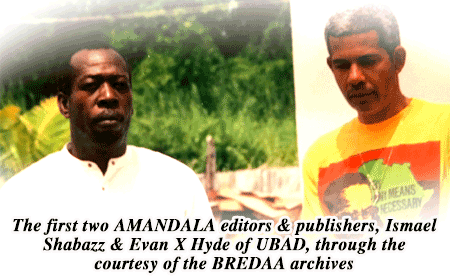THE BELIZEAN NEWSPAPER THAT BROKE THE LANGUAGE BARRIER!
Reading the book by the renowned Belizean writer, Evan X Hyde, North Amerikkkan Blues, at the young age of 16 years old as a high school student in Belize in the 1970s, lifted my educational spirit and opened my passion for writing after Dr. Colville Young, who was the principal of the historical St. Michael’s College, wrote an essay on the arts for us to copy that exploded with the opening sentence, “The art of a person begins when someone in the community feels the urge to create!”
Almost forty-five years ago after reading what to me was literature that my soul could find itself in, the other best reading material for me that connected with me in terms of reading something enjoyable was the AMANDALA newspaper. This was the 1970s and Belize’s high schools were placing some serious academic pressure on Belizean students. Those whose household language was not the “Queen’s English” had problems that Belize’s colonial slave society left as the language of choice and status.
Belizean students that could not cope with the grueling academic language failed because they couldn’t read, write and understand in Standard English. And so the harshly graded compositions and essays, coupled with low scores, sent a serious message that this kind of “pat-wa-bonics” will not be tolerated. We were supposed to be little English subjects that could write and speak common English with some kind of sense.
Reading anything around the house from Belizean newspapers, especially AMANDALA, that sounded more “Belizean” than Shakespeare for me was a relief, since Belize’s British-orientated educational system demanded language skills as a means to tame the Kriole lingua franca so as to pass the nerve-wrecking GCEs from Her Majesty’s London, England. Language skills ruled the world from Africa to the Caribbean, Europe to Asia, and beyond. And if you want to be anything in life to make a living, you have to learn to read and write properly.
Belize’s Teachers College-trained educators were some of the best in the world, and for Belizean British subjects of the then British Honduras that were blessed with so much imagination because of not being exposed to television yet, reading and writing were mandatory from the primary school level. For many who resisted and failed miserably to pass the mark, however, the torture that they endured emotionally from a colonial mindset that became the norm for success and status was vicious. Those who rebelled against it found themselves as dropouts that resulted most of the times in despair, marginalization, and finally displacement.
North Amerikkkan Blues and AMANDALA had allowed me to find my way on Monday mornings throughout those hectic and tiring academic high school exercises as a student. It made me cope fairly well to the language of the Belizean classroom that dictated as to how my language would prosper. It is kind of hard to explain the language of a grassroots Belizean newspaper like AMANDALA that was carved out by a Belizean writer and publisher who himself toiled and struggled socially and politically as a black Belizean radical straight out of an American university in the black power and civil rights 1960s. It appeared that he may have understood that there were Belizeans who spoke only the broken English of the British Caribbean and fortunately bridged the Belizean language gap in one of the best forms of creative writing perhaps in the Caribbean.
While in Belize recently, it was good seeing Dr. Colville Young again, who is also Belize’s Governor General, at one of the major supermarkets on Belize City’s Northside. My mind nagged at me to approach the distinguished Belizean scholar of Belizean and Caribbean linguistics and to prompt him again about the essay, “The Art of a Person”. He also wrote the book, “Belize Creole Proverbs”. Being such a polite man who had ruled our domain at St. Michael’s in the 70s with much love for artistic appreciation, especially the appreciation for our own Belizean “Kriole”, he remarked with a smile that he doesn’t quite remember, it being such a long time, but that he was glad that it taught me something.
The language of the AMANDALA appears to be fundamentally the language of the Belizean people called “Krioles”. It appears that the reason Belizeans connect so well with the newspaper may be because it spoke to them in a way that they could understand. There is a language in everything and to reach people it’s best to know how to communicate. In the AMANDALA is a Belizean language of news and views that was able to reach the people at a time in Belize when there wasn’t any television, much less social media. AMANDALA as a Belizean educational and entertainment medium spoke to the people and for the people to become the most popular newspaper in the country of Belize today.

